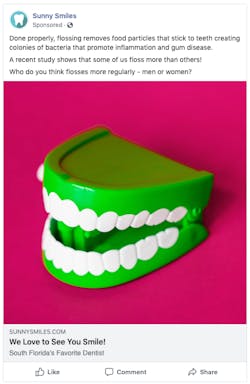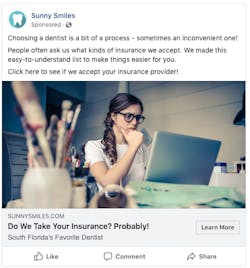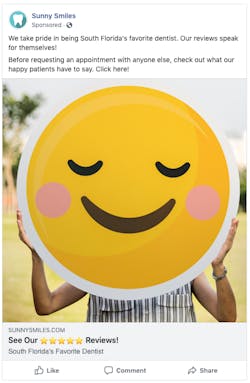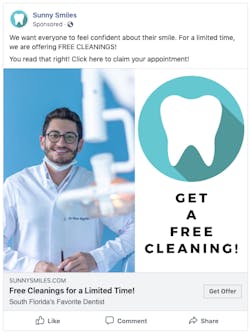What is funneling, and how can it work for your dental practice?
Imagine you’re trolling Facebook and see an ad from Walmart promoting a bundle of brand name cleaning supplies, such as Bounty paper towels and Clorox bleach, all delivered to your door at a great price. You know Walmart, and you know the brands and companies that make those brands. So, if you need cleaning supplies and you like to save money, there are very few hurdles to making the buy.
Now let’s assume you’re trolling Facebook and see an ad about a dental practice called Sunny Smiles, a real dental practice in south Florida. Thud! What’s Sunny Smiles and why do I care, you ask? This is precisely the challenge faced by dental practices with their digital advertising. They may be getting exposure in all the right places, but how do they raise the level of interest among prospects beyond “Meh”?
Enter funneling, which enables advertisers to send new ads to prospects based on their engagement with previous ads. Funneling is made possible by Facebook Pixels, which are advanced codes that offer advertisers capabilities that were unheard of just five years ago. This article will demonstrate a funneling program.
Stage 1: Awareness
The first step of an effective funnel for a dental practice is targeting users with an offer or solution that will capture their attention. The key is to make your advertisement so compelling that users engage with it, or visit your website, or watch the video.
In the examples below, ad example 1 (left) encourages users to visit the office’s website to learn more about their services. Ad example 2 (right) encourages users to engage with the content. The key is that through Facebook Pixels, whatever actions users take will initiate a funneling sequence, which will enable the dental practice to target them later with another tactic.
Stage 2: Consideration
At this stage, the funnel targets the users who interacted with the content from Stage 1. Now that they’re aware of the practice they’re more likely to proceed to the next step. Accordingly, the objective of the ads below is to get users to visit a landing page that has more focused messaging. This messaging might inform users why this practice is the best option, and how it removes barriers related to insurances accepted, languages spoken, or even free parking. Ad example 3 (left) showcases positive reviews that speak to the quality of care patients receive. Ad example 4 addresses insurance issues. Remember, not all prospects will engage at Stage 2. In fact, most won't and that’s OK. Those who do are self-qualifying and closer to becoming patients.
Stage 3: Decision
At Stage 1, the campaign generated awareness among prospects. At Stage 2, those who took action at Stage 1 were retargeted with more direct ad copy. At Stage 3, the campaign strives to give prospects an offer that is difficult to refuse. This might include a free cleaning or discounted services, as shown in the ads below. Since the goal is to add new patients, and since there is a wide variety of potential needs, it’s important to have a wide variety of teaser offers.
Stage 4: Circling back
At this portion of the funnel, users have either converted or they haven’t. If they have, this is a great opportunity to retarget them with a new funnel to keep your practice top-of-mind and to make sure they make that appointment. This is shown in ad example 7. If they have not, Stage 4 offers a chance to deploy a harder sell, as in ad example 8.
Funnels can be either shorter or much longer than four stages. In addition, there can be a variety of ads with the same message at each stage to help determine which ones worked best. Regardless, the conceptual framework—creating awareness and making offers based on the actions taken by your targets—works well for dental practices because it helps them overcome the challenges of developing large scale brand awareness. For dental practices, a slow drip educational process works well, and funnel programs enable practices to do this with the same sophistication as a large consumer products company.
Shay Berman is the founder and president of Digital Resource, an internet marketing agency that specializes in helping dental practices increase their patient volume and revenue through innovative digital marketing programs. Mr. Berman attended Michigan State University, where he learned from some of the Google executives who taught there. This knowledge, along with extensive experience in the dental business, has been instrumental in his success advising dental practices. Contact him at [email protected].
About the Author
Shay Berman
Shay Berman is the founder and president of Digital Resource, an internet marketing agency that specializes in helping dental practices increase their patient volume and revenue through innovative digital marketing programs. Mr. Berman attended Michigan State University, where he learned from some of the Google executives who taught there. This knowledge, along with extensive experience in the dental business, has been instrumental in his success advising dental practices. Contact him at [email protected].








